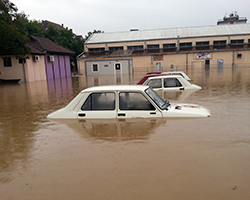Health hazards: non-infectious

WHO
Non-infectious health hazards describe a variety of occurrences which can be divided into those caused by natural phenomena and those caused by human activity. WHO is a part of the Cluster Approach, a network of United Nations (UN) and non-UN partners that collectively prepares for and responds to humanitarian emergencies, including public health emergencies. WHO is the lead agency for the Health Cluster, while other agencies coordinate sectors of humanitarian action such as water, food security and protection.
The WHO Regional Office for Europe works closely with Member States and international and national partners to help communities:
- prepare for disasters;
- deal with their health consequences; and
- mitigate their long-term effects.
Natural
Emergencies due to natural hazards are a serious threat to public health. They range from sudden-onset emergencies such as earthquakes, to events which occur with limited warning such as droughts. WHO works with Member States to provide a full range of activities to reduce the health impact of such emergencies, ranging from prevention and preparedness to response and recovery.
Earthquakes
Earthquakes occur when waves moving on and below the earth’s surface cause shaking and can result in surface faulting, tremors and vibration, liquefaction, landslides, aftershocks and/or tsunamis. In addition to trauma-related deaths, the health impact of earthquakes can include secondary infection of untreated wounds, the spread of communicable diseases, and increased psychosocial needs. Disruption of health infrastructure and services can also have serious implications.
Earthquakes - Technical guidelines
Drought
Drought is a prolonged dry period in the natural climate cycle. It is a slow-onset phenomenon caused by rainfall deficit combined with other predisposing factors. In a drought, reduced food intake and lack of a varied diet can lead to protein-energy malnutrition and micronutrient deficiency. Displacement and a lack of water supply and sanitation services puts vulnerable and malnourished populations at increased risk of infectious disease spread.
Drought - Technical guidelines
Floods
Floods are the most common natural disaster in the WHO European Region and may become more common as extreme rainfall is projected to become more frequent. Drowning is the leading cause of death in floods with other health risks including electrical shocks and injuries from sharp debris. Flooding can also lead to an increased risk vector-borne diseases as standing water can act as breeding sites for mosquitoes. Impact on health infrastructure can also be considerable.
Landslides
Landslides can be a secondary effect of heavy storms, volcanic eruptions and earthquakes. Landslides cause high mortality and few injuries. There is also a risk of short- and long-term mental health effects.
Landslides - Technical guidelines
Volcanic activity
Primary volcanic events include pyroclastic explosions; hot ash releases; lava flows; gas emissions; and glowing avalanches (gas and ash releases). These can cause secondary events like fire, as well as melting ice, snow and rain which are likely to trigger floods and hot mudflows. As well as death and injury resulting from the direct impact of volcanic activity, other risks include skin and lung burns, respiratory distress and eye damage.
Volcanic eruptions - Technical guidelines
Wildfires
Wildfires can be started both by people and by acts of nature. People and animals die, crops and resources are destroyed, while smoke can adversely affect the health of large groups of people outside the immediate area.
Vegetation fires - Technical guidelines
Human
Human-induced emergencies include a range of events resulting from accidents or attacks using chemical-biological-radioactive-nuclear materials, climate change and other environmental damage. Human activity with devastating effects can include acts of terrorism, and war and civil conflict within and between countries, which have the potential to feed into other emergencies such as refugee flows.
Technological incidents
Technological disasters, for example from chemical or nuclear power plants, often result in an unexpected and uncontrolled release of hazardous materials that have the potential to cause health problems, such as the disasters that have occurred at Chernobyl and Bhopal.
Complex emergencies
Complex emergencies combine internal conflict with large-scale displacement of people, mass famine or food shortage, and fragile or failing economic, political and social institutions. Often, complex emergencies are also exacerbated by disasters associated with natural hazards.
Deliberate events
A deliberate event is an act (or threat) involving the intentional release of hazardous substances to cause harm, for example for terrorist purposes. Hazardous substances include chemicals, biological agents and radiological materials. Deliberate events cover a wide spectrum of intent and public health impact.



